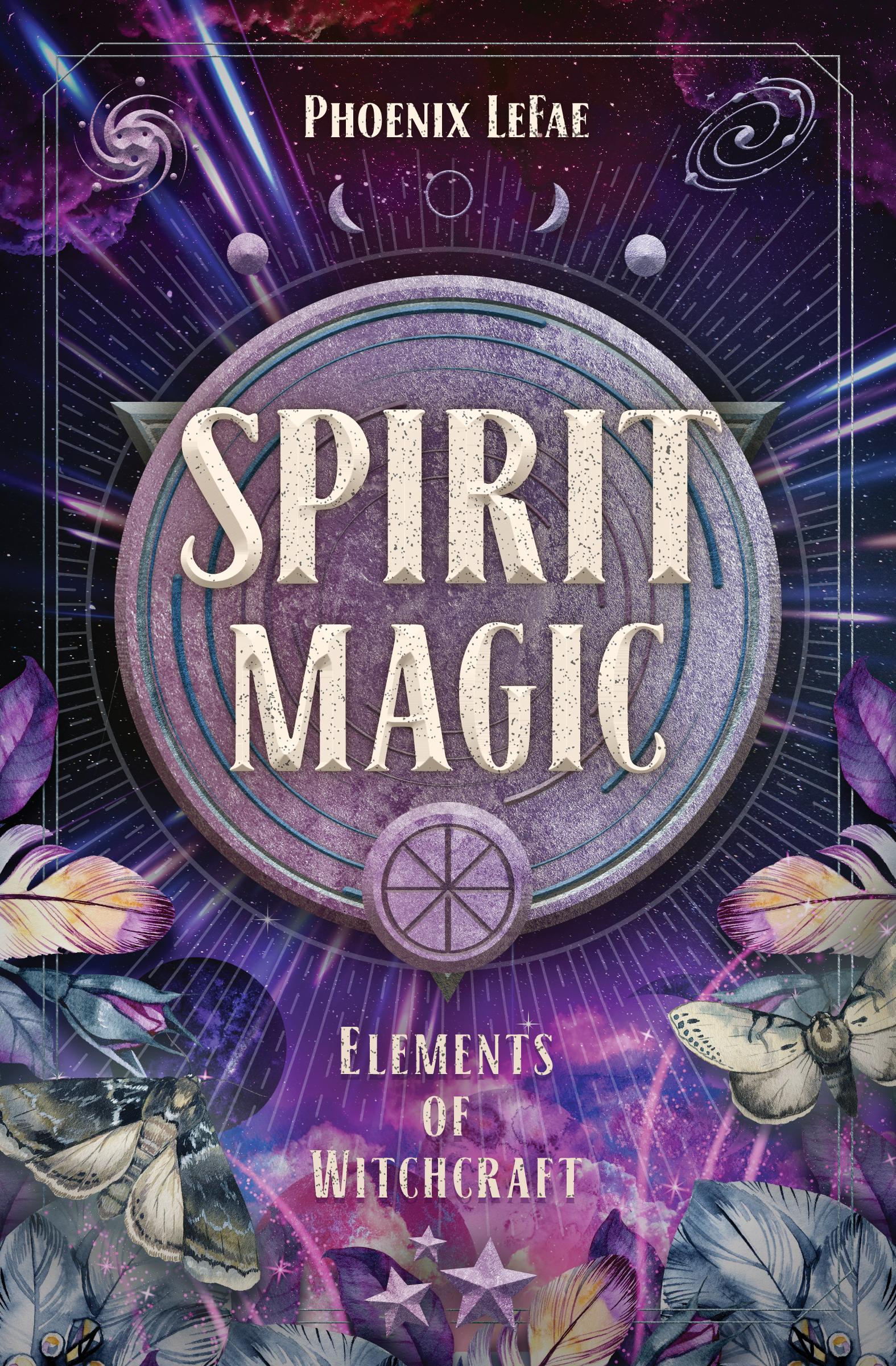







Phoenix LeFae (she/her) started her journey in the world of Witchcraft in 1993 when her athame was a wooden-handled butter knife stolen from her mom’s kitchen. Her love of magick and mystery has led her down many paths, lineages, and traditions. She is an initiate in the Reclaiming Tradition of Witchcraft, the Avalon Druid Order, and Gardnerian Wicca. Phoenix has written several books, including What Is Remembered Lives, A Witch’s Guide to Creating and Performing Rituals, Witches, Heretics & Warrior Women, and more. She is a professional Witch and the owner of the esoteric Goddess shop Milk & Honey, www.Milk-and -Honey.com. Find out more at www.phoenixlefae.com.
Spirit Magic Copyright © 2026 by Phoenix LeFae. All rights reserved. No part of this book may be used or reproduced in any manner whatsoever, including internet usage, without written permission from Llewellyn Worldwide Ltd., except in the case of brief quotations embodied in critical articles and reviews. No part of this book may be used or reproduced in any manner for the purpose of training artificial intelligence technologies or systems.
first edition
First Printing, 2026
Cover design by Shannon McKuhen
Interior illustrations by Llewellyn Art Department
Tarot Original 1909 Deck © 2021 with art created by Pamela Colman Smith and Arthur Edward Waite. Used with permission of LoScarabeo.
Llewellyn is a registered trademark of Llewellyn Worldwide Ltd.
Library of Congress Cataloging-In-Publication Data (Pending)
ISBN: 978-0-7387-7940-9
Llewellyn Worldwide Ltd. does not participate in, endorse, or have any authority or responsibility concerning private business transactions between our authors and the public.
All mail addressed to the author is forwarded but the publisher cannot, unless specifically instructed by the author, give out an address or phone number.
Any internet references contained in this work are current at publication time, but the publisher cannot guarantee that a specific location will continue to be maintained. Please refer to the publisher’s website for links to authors’ websites and other sources.
Llewellyn Publications
A Division of Llewellyn Worldwide Ltd. 2143 Wooddale Drive Woodbury, MN 55125-2989
www.llewellyn.com
Printed in the United States of America
GPSR Representation:
UPI-2M PLUS d.o.o., Medulićeva 20, 10000 Zagreb, Croatia matt.parsons@upi2mbooks.hr
This book is dedicated to my partner and biggest cheerleader, Gwion Raven

Disclaimer … xiii
Foreword: The Unknowable Force of Spirit … xv
Introduction: The Fifth Element … 1
Part 1: History, Folklore & Myth
Chapter 1: Spirit Throughout Time and Culture … 9
Chapter 2: Mythological Spirit Beasts and Places … 21
Chapter 3: Spirit and the Divine … 35
Chapter 4: Sacred Spirit Sites … 51
Essay: The Foundation of Life and Magic by Dodie Graham McKay, 55
Part 2: Working with the Element of Spirit
Chapter 5: The Element of Spirit in Magic … 71
Essay: Breath and Sea by Astrea Taylor, 77
Chapter 6: Spirit Herbs and Botanicals … 95
Chapter 7: Spirit Crystals and Stones … 107
Essay: The Spirit of Water by Lilith Dorsey, 114
Chapter 8: Spirit Animal Guides … 119
Chapter 9: Intuition and Divination … 139
Chapter 10: Drawing Down and Aspecting … 155
Essay: Fire and Spirit by Josephine Winter, 163
Chapter 11: Spirit Spells, Recipes, and Rituals … 173
Chapter 12: Holiday Rituals and the Spirit Wheel of the Year … 197
Conclusion … 237
Acknowledgments … 239
Appendix: Spirit Correspondences … 241
Bibliography … 243 Index … 249
“Nature always wears the colors of the spirit.”
—Ralph Waldo Emerson, Nature, 1836

This book is not intended as medical or psychological advice. Any activities suggested here should be approached with care and caution. If you require medical assistance or mental or physical care, please seek help from professionals. Avoid performing any rituals or practices in this book if they could cause you harm, either physical or psychological. Refrain from using any items suggested in this book if you are allergic or uncertain about a possible allergic reaction. Herbs that are marked as poisonous are provided solely for informational purposes. Do not use them.

For centuries and through many esoteric practices, the elements have been the cornerstones of magical practice. Whether it’s ancient astrology or modern Witchcraft, these four basic elements create the boundaries and structures for larger, multidimensional spiritual frameworks.
Earth is the ground we walk on, quite literally. It is the rocks, the mud, and the mountains. Earth is also our body and our physical manifestation in this life. Earth is our center, our money, and our stability.
Fire is the flame in the hearth. It is the candle, the bonfire, the sun. Fire both warms and destroys. It has the power to transform and incite. Fire is the flame of passion and our will to go on.
Water is the rain from the skies. It is the world’s oceans, lakes, and rivers. It is a comforting bath and the morning dew. Water is our blood, sweat, and tears. It rules our emotions and manifests as memories.
Air is all around us. It is the sounds we hear and the wind that touches our faces. Air carries seeds and pollen and the scents that both warn and delight. Air is our voice, our thoughts, and our ideas.
But in many traditions and esoteric practices, there is also a fifth element: Spirit. It is the merger of all the elements, yet it is far more than the sum of those parts.
Spirit is unknowable yet all around us. It is untouchable, yet it is us. It is an essence, our soul, and that aetheric thing that gives everything life.
For modern Witches, Spirit can be found at the center of the magic circle and the celebratory Wheel of the Year. It spins in ritual as calls to deity are made and whispers to the soul in meditation and divination. In the occult world, Spirit is represented by the six-pointed star, which is a blend of the alchemical symbols for the four elements. For still others, Spirit can be found in a walk through the forest in the movement of plants, the call of animals, and the energy of the land.
This book is the fifth and final in a series that dives deep into the symbolism and spiritual use of the elements. The first four books, beginning with Water, highlighted each of the building blocks that make up Spirit. This one brings it all together, covering everything associated with the element of Spirit, from spiritual places and deities to practical spells and rituals.
Written by five different authors from around the globe, the Elements of Witchcraft series will show you just how wide and deep the esoteric understanding of the elements goes and how to make their fundamental lessons work for your own magical and spiritual needs.
Join us on a deep exploration and journey of the magical use of the four—no, five—elements.
By Heather Greene Acquisitions Editor, Llewellyn Worldwide
When I first started practicing Witchcraft, I was taught that Spirit exists in all the elements and all the elements exist in Spirit. Spirit is the all and the nothing, the deepest reaches of space. It is dark matter, which holds the universe together, meaning we don’t totally understand it. Spirit is ineffable—it cannot truly be described because it is a thing that is beyond the use of words. Spirit is the center of the circle, the animating force that keeps us alive, and the stuff magic is made of. Spirit is the elusive fifth element.
When it comes to Spirit within the framework of modern Witchcraft, we have to ask if acknowledging this “fifth” element is necessary. In many Witchcraft traditions, Spirit isn’t called or honored in a ritual framework. Where you might see invocations (or evocations) to the elements of Earth, Air, Fire, and Water, Spirit is often left out. And yet there are plenty of other traditions where there is a calling to Spirit, even if that is just with a silent nod or a pentacle drawn in the center of the ritual circle. In this inclusion and exclusion, we see a reminder that Spirit is a paradox.
In Western Witchcraft traditions, the other elements have directional assignments. Air is generally connected to the East, Fire to the South, Water to the West, and Earth to the North. So where is Spirit?
Spirit, of course, is in all these directions and all these elements; Spirit is the guardian of the center. Sounds simple enough, except for the fact that center is a moving target. The center isn’t the same place for every person. My center is here within me and your center is there within you, and yet they are both center. There is a center of a ritual circle and at the same time there is a center of the ritual space—and these may or may not be the same place.
Many Western Witchcraft traditions also connect the elements to the directions and the directions to a guardian of a Watchtower that resides in that direction. Each element is called into ritual by calling upon the power of each of these Watchtowers.
The concept of the Watchtowers originated in the writings of John Dee and Edward Kelley, who worked magic in the 1500s involving angels, which is now referred to as Enochian magic. John Dee was the court astrologer for Elizabeth I, and Edward Kelley was a famous occultist. They explored the concept of an angel guarding and protecting each cardinal direction and the element associated with that direction. Earth is the realm of Uriel, Air is connected to Raphael, Fire is the realm of Michael, and Water is connected to Gabriel. The Hermetic Order of the Golden Dawn, formed in 1888, then popularized this idea.
But there isn’t a Watchtower for Spirit because there isn’t a Watchtower in the center, so does that mean it’s not a traditional element?
Of course, this elusive nature is part of the thrill of working with Spirit as an elemental force. It is paradoxical and magically slippery.
Although one might argue that Wicca is an offshoot of Western Witchcraft, this system views the concept of Spirit as con-
nected to matter. Wicca is an Earth religion that views the four elements as matter, and Spirit should not be separated from matter, meaning there is no reason to acknowledge Spirit as the fifth element because it is already inherently connected to the four material elements. Matter and Spirit are intertwined and impossible to pull apart.
Outside of the Witchcraft traditions inspired by Western occult practices, animism looks at everything in the world (the universe) as having its own inherent Spirit. Many modern traditions of Witchcraft are moving closer to an animistic worldview, honoring everything around us as alive and possessing Spirit. Is this view of Spirit the same as or different from a directional Spirit? And does it matter?
If we look to the East, we discover another practice related to the five elements. In Chinese medicine and spiritual philosophy, the five elements are Earth, Wood, Fire, Water, and Metal—Spirit is not part of this elemental mix. However, this system recognizes Spirit as the animating force that influences all five elements. In this system, Spirit is referred to as chi or qi.
In Ayurvedic medicine, we also see the practice of working with five elements. This tradition honors Air, Fire, Water, Earth, and Aether, or Akasha. Both Aether and Akasha are words for Spirit, and in older esoteric traditions the word Aether (or Ether) was used rather than Spirit.
These are just a handful of ways to look at Spirit in a spiritual context. It is by no means a simple conversation. Spirit is as Spirit does. Spirit is what you make of it. At the end of the day, you are your own spiritual authority, and how you relate, or don’t relate, to Spirit is totally up to you.
Your mileage in a ritual context may vary. Honestly, that is what makes modern Witchcraft such a fascinating topic. There are
many ways to approach magic and ritual. There isn’t just one true way but rather lots of ways that help us connect to the larger spiritual world around us.
This book is a love letter to Spirit. Dip in and out of the pages and places that call to you. Flip through the book and perform bibliomancy to help you in your spiritual work. Let your Spirit guide you in your exploration of the world of Spirit. And if you want bonus Witch points, read the other books in this series—Water Magic, Air Magic, Fire Magic, and Earth Magic—to help you have a well-rounded approach to the elements in the world of the modern Witch.
If you have read enough books and followed their directions, you likely have dozens of journals, each dedicated to a specific training or book. This is something I have recommended in my other books. Having a journal for specific workings can help you to focus and have clarity on that topic. Plus, it helps you to look back at the work and remember. With this book, however, I don’t suggest getting a brand-new journal. Instead, I simply encourage you to journal. When you have a hit on something, when a question pops into your head, or when anything comes up that might require more research or introspection, write that down in your journal.
And by journal, I mean that pretty blank-paged book that you bought for magical use, a Word document on your computer, your Notes app on your phone, or anything that you regularly check and read over. Journaling isn’t just about writing down the thing; it’s about going back to it and remembering it or reconnecting to
it. Journaling is a way to reflect on your magic and your path as a spiritual being. So write down those interesting or curious things when they pop up, and they might open up a whole new world of Spirit.
Exploring the elements is fundamental to a spiritual practice. It doesn’t matter your level of experience, training, or the number of initiations you’ve had; connecting with the power of the elements will enhance any Witchcraft practice at any stage.
If you are new to magic, this book and the other books in this series will be a solid introduction to working with the unseen and seen realms magically. If you are an experienced practitioner, this book can help deepen your relationship to Spirit and the mystery that is all around us.



“I was born by myself but carry the spirit and blood of my father, mother, and my ancestors.”
—Ziggy Marley

Spirit can be a lot of things, as noted in the introduction. Spirit can refer to the human soul, the energy of the land, the unknown or unseen, gods, and so much more. However, when we look at the word Spirit in relation to the word Aether, we can more easily follow the trail from ancient Western magical traditions to the practices of modern Witches.
Although the concepts of ghosts as spirits, the soul as a spirit, and the energy of ethereal beings that we might call spirit will come up in the chapters of this book, the goal here is to focus on Spirit as an element. In these pages we will address how Spirit shows up as an element and explore some of the practices and traditions connected to modern Witchcraft through the lens of that element.
A specific group of ancient peoples—whom we now refer to as medieval scientists but who could also easily be called Witches, alchemists, philosophers, or doctors—referred to Spirit as Aether or Quintessence. These were their terms for the material that exists
beyond the earth. We might interpret this as relating to space or the solar system or even the larger universe, yet it is simultaneously much smaller than that. Aether pertains to concepts not fully understood by medieval scientists that which we now have names for, such as gravity, light, particles, cells, and sound waves.
Magic has always been connected to what is unexplainable.
Concepts that were once viewed as magic or Quintessence in the past have since been given names, descriptions, and explanations by modern science. However, just because something has a name and a definition doesn’t change the fact that it is magical and mysterious. We might understand gravity as a scientific principle, but most of us don’t grok the full depth of what gravity means and what it does. We get it because we experience it, but many of us don’t understand the mathematics and science of how it works— and the good news is we don’t need to. As with magic, we don’t need to understand how gravity, light, or sound work to know that these things exist.
But science is only one part of how we look at the concept of Spirit. We can also see the impact of Spirit in the realms of sociology, philosophy, and history.
In ancient Greece, sometime between 750 and 650 BCE, Aether was viewed as the very air that the gods breathed, meaning it was charmed and full of mystery, literally the gods’ breath, which is quite a magical idea. Anything we humans didn’t yet understand or have language for would fall into the category of the gods’ breath. The famous Greek writer Homer described Aether as pure, fresh air and clear sky.1
1 DeLay, “The Life and Death of the Aether (Part I).”
In the fourth century BCE, Plato wrote about the classical elemental system and the four elements of Air, Fire, Water, and Earth, but he also wrote of Aether as the “most translucent” of the elements. According to Plato, who was a student of Socrates, the four classical elements are stuck here on earth and exist only in connection to our planet. Spirit, or Aether, however, according to his worldview, is celestial and doesn’t have any of the qualities you would find with the classical four because it isn’t bound to the planet.
Aristotle, a student of Plato, further defined Aether in his treatise On the Heavens. In these works, he explained that Aether naturally moves in circular patterns and exhibits no unnatural motion. He noted that the movement of the planets and the solar system occurs in a circular fashion, implying that all celestial bodies are connected to the energy of Aether. He also referred to Aether as the primary matter.
Medieval alchemists, who practiced from the twelfth to the seventeenth centuries CE, also worked with Spirit, or Aether, but they called it Quintessence. Those who studied alchemy didn’t believe that Quintessence had much of a presence on earth. Rather, they believed that the impact of Quintessence on our planet happened through how the other planets and celestial bodies impacted the earth.
During this time, medieval alchemists attempted to isolate, unravel, and understand the discipline that we now call astrology, believing this was part of the key to a deeper understanding of life and the universe. They wanted to gain power over healing and magic and thought the key to this was to harness Quintessence. These magicians wanted to use the pure energy of Quintessence
to rid themselves of any impurities and become more powerful beings. The creation of the alchemists’ famed philosopher’s stone, which, once created, could offer never-ending life, required the use of Quintessence in the directions. As of now, no one has successfully created the philosopher’s stone.
For the alchemist, connecting with Aether allowed the practitioner to enter a state of transcendence and receive divine intervention. In this view, Spirit connects the physical realm with the spiritual realm, allowing humans to connect to something greater than themselves.
With the development of modern physics, many alchemical viewpoints on Aether and Quintessence slowly became scientifically obsolete. Yet the concept of Spirit, or Aether, never completely disappeared. Some modern physicists still use the term Quintessence to describe dark matter or dark energy. Although physicists believe dark matter exists, they can’t explain how or why it works mathematically or scientifically. Quintessence in a modern scientific context still points to the potential of matter and energy.
Despite modern science’s rejection of many ancient concepts, spiritual seekers—such as alchemists, hermeticists, and occultists—continued to discuss Quintessence as a metaphorical concept well into the 1900s.
For example, in his 1908 book The Kybalion, William Walker Atkinson shared his seven Hermetic principles, which speak to Quintessence as part of their esoteric viewpoint. These principles are considered major keys to self-empowerment in the occult and are still used and discussed in today’s esoteric landscape.
The Hermetic principles create a spiritual structure in which you can manifest anything. These seven principles are as follows:
1. Principle of Mentalism—Everything that exists comes from the Divine Mind and we are part of that Divine Mind. There is no separation. Everything is part of one complex being. We are the dreamer and we are the dream.
2. Principle of Correspondence—“As above, so below.” What happens in the spiritual realms will impact the physical and vice versa. All is connected and all will move to balance each other at all times.
3. Principle of Vibration—Everything in existence has a vibration, which means that everything is in a constant state of motion. We can connect and relate to anything by connecting with the vibration of that thing.
4. Principle of Polarity—All existence is connected by extremes or poles. All things are dual and the poles connect the extremes.
5. Principle of Rhythm—There is a natural ebb and flow to everything in the universe. It is subject to natural cycles.
6. Principle of Cause and Effect—Chance does not exist in the universe. Everything happens because something came into play to make it happen. Every moment that happens (effect) has a cause that brought it about.
7. Principle of Gender—Gender manifests in everything. The use of the word gender is outdated. This concept is actually about how all things have projective and receptive energies.
All these thought processes, dreams, explanations, and so forth just further lean into the fact that there are forces in this world
that we can’t fully understand. And we call these concepts Spirit, Aether, or Quintessence.
Modern practitioners of Witchcraft use some, all, or many of these ancient descriptors in their practices. In regard to Spirit and Witchcraft, Jaq D. Hawkins, author of Elemental Spirits, said, “It encompasses the basis for all of the other elements and is believed by magicians to be the fabric of existence through which magic transmits.” 2 Spirit is the fabric through which magic transmits. This is really how it relates to what we do as modern practitioners.
One of the modern symbols connected to Spirit is the pentacle, a five-pointed star with a circle around it. This symbol shows the power of the five elements in unison. Earth, Air, Fire, Water, and Spirit all hold a point in the sacred star. Energy flows from one point to the next, creating the basis for magic in the universe.
The pentacle is a common symbol of power and protection in many modern Witchcraft practices. In many traditions, the pentacle is energetically used with a sacred knife called an athame , drawn at the four cardinal directions to create a magical container for rituals and spells.
2 Hawkins, Elemental Spirits, 22.
Speaking words is a form of magick. Allow Spirit to move through you with this activity. Find a time and place where you can be alone and undisturbed for at least thirty minutes. Allow yourself to get comfortable and relaxed. You should lie down or sit comfortably. Focus on your breath and allow your physical edges to feel like they are softening and expanding as you breathe. Let yourself breathe and open for a few minutes; don’t rush this process. When you feel open and relaxed, focus on the word Quintessence.
Simply repeat the word, either in your mind or out loud. Allow yourself to notice how it feels and what it brings up when you focus on it. Are there other words, images, sights, sounds, or feelings that come through as you meditate on this word? Repeat this process until you feel complete. When you are finished, write down anything odd or interesting that may have come up for you.
We can’t go deep into the concept of Spirit without taking into consideration the human soul. In many traditions, the terms Spirit and soul are used interchangeably. The soul, some might say, is the Spirit of the individual person. This is a modern Christian way of looking at the spiritual world. In this practice, the soul needs to seek salvation for eternity to be a positive experience and not endless torture.
In ancient Egypt, it was believed that the soul was made up of nine separate parts, each of which played an important role in life and the afterlife. Khat is the part of the soul that is the actual
physical body. This part needs to be preserved for use in the afterlife. Ka is the astral body made up of the individual’s personality. Ka is also the part of the soul that absorbs the energy from offerings left after death.
Ba is the spiritual force that can move between the body and the spirit realm. Shuyet is the shadow self, the shadow of Ka, or the astral body. Akh is the immortal self, the one that emerges when Ba and Ka are united.
Sahu is the ghost of the spirit. This is the part of the soul that can appear to others after the death of the individual. Sechem is the part of the soul that is enlightened and can help shift circumstances for the living from the afterlife. Ab is the heart, which is what defines an individual’s character and needs to be preserved after death.
Finally, Ren is the secret name given by the gods at the time of birth. All these pieces make up the Spirit of a human being both in the physical realms and in the spiritual afterlife.3
Many of the ancient Greek philosophers believed there was a triple soul. The first part of the soul is the one that contains all the appetites. These are all the things a human craves: food, sex, pleasure, comforts, etc. The second part is the spirited part. This is the part of the soul that gets engaged, angry, or riled up. And finally, the third part of the soul is the mind. This is the part of the soul that is in charge. This part is rational and forward-thinking, what modern Jungian practitioners might consider the talking self.4
In some Eastern spiritual systems, such as Mahayana Buddhism and Jainism, there is a belief in a triple soul. One of these souls
3 Mark, “The Soul in Ancient Egypt.”
4 Kerns, “Plato’s Three Parts of the Soul.”
stays with the body after death, one of the souls goes down into the underworld, and one of the souls goes up into heaven. Each soul serves its purpose for the individual, both in life and in the afterlife.5
If we look at modern spiritual practices, we find the triple soul in the Feri Tradition of modern Witchcraft. In the Feri Tradition, people have the talking self, which is the consciousness. This part of the soul is the one we hear in our heads. This voice is the director of our lives. The second part of the soul is called the fetch, which is the animal self or a child self. This part of the soul is wilder and more untamed, connected to the baser needs. Finally, the third part of the soul is the god-self, which could also be looked at as our superconsciousness. Each of these souls has a purpose, and when they align, we are performing at our best, for our highest good. Once again, we see the Spirit of the self not as just one thing, but as a relationship between various parts of being human.
The concept of a triple soul lays perfectly on top of the idea that the world is made up of triple realms. One could argue that the realms of the world around us encompass the Spirit of where we live. If humans contain a triple soul, why wouldn’t the universe also work within the bounds of a triple soul or Spirit?
The idea of the world being made up of triple realms is found in cultures worldwide. Many spiritual systems look at the world through a three-realm paradigm. In many of these systems, there is a central pole, tree, or axis that holds the world together.
In ancient Norse cosmology, the central pole of the multiverse is an ash tree called Yggdrasil. This world tree holds the three
5 Britannica, “Multiple Souls.”
realms within it. The roots of the tree are the lower worlds, which are often a place of mystery, death, and regeneration. The realm of humans is the trunk of the tree, also called the middle world. At the top of the tree, the branches and leaves connect to the upper worlds, where the gods and mysterious ones reside.
In the Poetic Edda, an ancient collection of old Norse mythology, Odin hung from Yggdrasil for nine days and nine nights, which is how the tree got its name. Yggdrasil translates to “Odin’s gallows” in Old Norse.
Yggdrasil is not only the frame that holds the world together, but also a living, breathing entity. Some creatures live in and among the trees. Some of these creatures cause harm to the roots or branches, while others share gossip between the different realms. The world tree is not immortal; it can be harmed. In this system of belief, the world, like the tree, will not live forever. It will come to an end at some point.
In Buddhist cosmology, there is a belief in a triple realm called Triloka. The lowest of these realms is the Desire realm, where humans live. The second is the Form realm, which is a physical realm that is separated from desire. The third realm is Formless, which is without desire or physicality.6
In shamanic practices, we see the three realms concept again. These are the Upper, Lower, and Middle Realms. The Upper Realms are etheric and spiritual. These are places beyond ego, where we can communicate with the gods and the spirits of higher vibration. The Lower Realms are connected to the deep. These are places of deep wisdom, earth, loam, and the darkness of the ocean.
6 Oxford Reference, “triloka.”
Deep wisdom is in these realms. The Middle Realm is where we humans live. It is the world that we know.7
Spirit is also explored in the occult concept known as the Witches’ Pyramid, which was first written about by Eliphas Levi in the early 1800s. Levi was a French occultist and author whose books are still popular in occult circles today. In his practice, to be a successful magician you had to adhere to the principles of the pyramid. The Witches’ Pyramid sits on four corners made up of the classical elements, Air, Fire, Water, and Earth.8
The element of Air holds down one corner of the Witches’ Pyramid. Air connects to the power “To Know.” By understanding Air, we understand the energy of what it is to have knowledge. With this awareness, we know that learning is a continual process, a never-ending unfolding.
The element of Fire holds down the next corner of the pyramid. Fire is connected to the power of Will. When we understand the power of Fire, we understand our own personal will. This is an important key to magic. In our practice, our will must be stronger than the thing we are facing.
The next corner of the pyramid is associated with the element of Water, which is connected to the power “To Dare.” What is more daring than water? Water is the flow of energy and movement, which shows us how to be daring in our magic. To dare means being brave enough to take action.
The final corner of the pyramid is anchored by the element of Earth, which teaches us the power of keeping silent. Magic occurs
7 Therapeutic Shamanism, “The Shamanic Journey: A Journey to the Three Shamanic Realms.”
8 Mankey, “The Witches’ Pyramid.”
when we learn to remain quiet about it. Once upon a time, keeping silent could have even been a matter of life and death in the practice of Witchcraft. In modern times, our magic can be diluted when shared before it is fully developed.
The power of the Witches’ Pyramid rests on the four corners of Air, Fire, Water, and Earth, but when they are combined, they create the point at the top. This pinnacle of the pyramid is where we direct our magic. Some groups call this point “To Go” or “To Go into the World.” It is at this point that the power of Spirit comes into play. Spirit moves the energy of the elements into the realm of magic and manifestation.
Wicca and many traditions that have branched off from Wicca acknowledge only the four elements in their ritual structure. Spirit is seen as the animating force that moves in and between the other elements. In the Wiccan ritual format, there is a spoken acknowledgment to Air, Fire, Water, and Earth, while the center of the circle is acknowledged silently. It is the center of the circle and not the element of Spirit.
The way people have viewed and worked with Spirit over the centuries has changed and evolved. Spirit can show us how much science, technology, and magic have in common. Whether we call it Aether, Quintessence, black matter, or Spirit, we know there is a lot out there that we don’t understand. That’s what Spirit is all about.
“Whether you’re grounding in the fundamentals of the Craft or reenergizing your practice, Spirit Magic will help you soar to new heights. Through clear and easyto-follow background information and practical how-tos, Phoenix leads you on a transformational journey to learn about and experience the power of Spirit.”
—Enfys J. Book, author of Queer Rites
Packed with spells, rituals, exercises, recipes, and more, this book shows you how to enrich your connection to Spirit. Phoenix LeFae shares a variety of fun and fascinating ways to better understand and work with this paradoxical element, from its presence throughout history and cultures to the spiritual superconsciousness in crystals, herbs, and animals.
Spirit Magic also features essays from the other four authors in the Elements of Witchcraft series: Lilith Dorsey, Astrea Taylor, Josephine Winter, and Dodie Graham McKay. This book delves into Spirit-based holidays and the Wheel of the Year, how the Divine is entwined with Spirit, and how to draw down the Spirit element. Whether you’re interested in sacred sites, tarot, or astrology, this love letter to Spirit will help you deepen your Witchcraft and appreciation of the elements.
PHOENIX LEFAE is a professional reader, rootworker, teacher, and ritualist. She has been practicing Witchcraft for almost thirty years, and her teachings are connected to the Reclaiming Tradition, Druidry, and Gardnerian Wicca. She is also the owner of an esoteric Goddess shop called Milk & Honey. In addition to being the coauthor of Life Ritualized, she is the author of A Witch’s Guide to Creating & Performing Rituals, What Is Remembered Lives, and Witches, Heretics & Warrior Women. Visit her at PhoenixLeFae.com.
Facebook.com/LlewellynBooks
X: @LlewellynBooks
Instagram: @LlewellynBooks
www.Llewellyn.com

$18.99 US